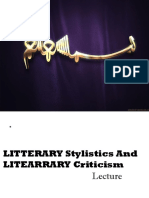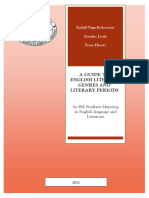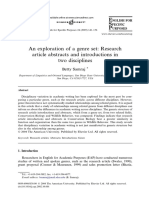0 ratings0% found this document useful (0 votes)
41 viewsWritten Texts, Marked by Careful Use of Language, in A Literary Genre
Written Texts, Marked by Careful Use of Language, in A Literary Genre
Uploaded by
fordownload useLiterary works are typically characterized by three things:
1) They are written texts marked by careful use of language including techniques like metaphors, well-turned phrases, and meter.
2) They fall into established literary genres like poetry, prose, or drama.
3) They are intended by the author to be read aesthetically and contain intentional ambiguities open to interpretation.
Copyright:
© All Rights Reserved
Available Formats
Download as PDF, TXT or read online from Scribd
Written Texts, Marked by Careful Use of Language, in A Literary Genre
Written Texts, Marked by Careful Use of Language, in A Literary Genre
Uploaded by
fordownload use0 ratings0% found this document useful (0 votes)
41 views1 pageLiterary works are typically characterized by three things:
1) They are written texts marked by careful use of language including techniques like metaphors, well-turned phrases, and meter.
2) They fall into established literary genres like poetry, prose, or drama.
3) They are intended by the author to be read aesthetically and contain intentional ambiguities open to interpretation.
Original Title
5_PDFsam_MeyerWhatisliterature
Copyright
© © All Rights Reserved
Available Formats
PDF, TXT or read online from Scribd
Share this document
Did you find this document useful?
Is this content inappropriate?
Literary works are typically characterized by three things:
1) They are written texts marked by careful use of language including techniques like metaphors, well-turned phrases, and meter.
2) They fall into established literary genres like poetry, prose, or drama.
3) They are intended by the author to be read aesthetically and contain intentional ambiguities open to interpretation.
Copyright:
© All Rights Reserved
Available Formats
Download as PDF, TXT or read online from Scribd
Download as pdf or txt
0 ratings0% found this document useful (0 votes)
41 views1 pageWritten Texts, Marked by Careful Use of Language, in A Literary Genre
Written Texts, Marked by Careful Use of Language, in A Literary Genre
Uploaded by
fordownload useLiterary works are typically characterized by three things:
1) They are written texts marked by careful use of language including techniques like metaphors, well-turned phrases, and meter.
2) They fall into established literary genres like poetry, prose, or drama.
3) They are intended by the author to be read aesthetically and contain intentional ambiguities open to interpretation.
Copyright:
© All Rights Reserved
Available Formats
Download as PDF, TXT or read online from Scribd
Download as pdf or txt
You are on page 1of 1
4 Jim Meyer
s are written texts
s are marked by careful use of language, including features such as creative
metaphors, well-turned phrases, elegant syntax, rhyme, alliteration, meter
s are in a literary genre (poetry, prose fiction, or drama)
s are read aesthetically
s are intended by the author to be read aesthetically
s contain many weak implicatures (are deliberately somewhat open in
interpretation)
Written Texts, Marked by Careful Use of Language, in a Literary Genre
The most basic characteristic of literature, it seems to me, is that a literary work is a verbal
text. Further, a good example of a literary text will be written: although we can speak of oral
literature, the fact that we need to use the qualifier ‘oral’ indicates that such texts are not the best
examples—not the prototypes—of literature.
That characteristic alone would include all kinds of texts which might be considered
literature: cereal boxes, found poems, advertisements, shopping lists. And if some wish to call
such texts literature, I have no objection; these characteristics, remember, are not a checklist
which will keep some texts out of the category of literature. However, prototype theory suggests
that there will be less agreement on calling these literature, and that those speakers of English
who do so will express less confidence that everyone will agree with them.
In fact, the second characteristic listed above is also quite important: that literary texts are
marked by careful use of language, including features such as creative metaphors, well-turned
phrases, elegant syntax, rhyme, alliteration, meter. This, it seems to me, is quite significant in
establishing the meaning of the word ‘literature’: on the basis of this criterion, carefully-written
personal essays are more likely to be considered literary than are, for example, encyclopedia
articles. This characteristic may also provide some explanation for the use of the word ‘literature’
to mean the published research in a particular field: such literature, in addition to be written text,
must also exhibit features of careful use of language according to particular standards.
However, personal essays and researched articles do not meet the third characteristic:
prototypical literary works are written in the literary genres of poetry, prose fiction, and drama.
Note that I am not restricting the term ‘literature’ to these three genres; rather, I suggest that
works in these three genres provide, to speakers of English, the best examples of the word
‘literature’. Works in other genres are often considered literature, but again terminology which is
used to describe such works—terms like ‘literary non-fiction’—indicate that such texts are not
prototypical literary works.
Aesthetic Reading and the Author’s Intention
In the example of the word ‘bird’, we noted that the prototypical bird—the birdiest bird—had
features which were, from a criterial approach, not necessary to the definition. Thus, birds which
fly and sing and are of a particular size, birds such as robins and canaries and sparrows, were
consistently ranked as better examples of the category ‘bird’ than were birds which do not fly or
sing, birds such as owls and penguins and ostriches. Flying, singing, and fitting into an average-
size cage are not features of the criterial definition of ‘bird’; they are, however, characteristics of
prototypical birds.
For the term ‘literature’, I believe it is important to note that prototypical literary works
cannot be identified solely on the basis of their written forms. We must also consider the way in
which readers interact with them. I have used the term ‘aesthetic’ as proposed by Louise
You might also like
- (Lori M. Campbell) Portals of Power Magical AgencDocument227 pages(Lori M. Campbell) Portals of Power Magical AgenchafyojodreNo ratings yet
- Literature Note. Js1. First TermDocument7 pagesLiterature Note. Js1. First Termsaidu musa100% (1)
- The Belles - Letters StyleDocument2 pagesThe Belles - Letters StyleslnkoNo ratings yet
- Stylistic Analysis of A PoemDocument13 pagesStylistic Analysis of A PoemYāsha Hernandez100% (1)
- Jolly 2005Document29 pagesJolly 2005Darija KuharicNo ratings yet
- Genre of Conversation)Document5 pagesGenre of Conversation)Geean100% (1)
- English 8Document81 pagesEnglish 8Cray Cray100% (4)
- Creative Writing & Academic WritingDocument14 pagesCreative Writing & Academic WritingKaye Ortega Navales Tañales100% (1)
- Creative Non FictionDocument11 pagesCreative Non FictionJessa Landero Bahandi100% (1)
- 21st Century Literature IntroductionDocument20 pages21st Century Literature IntroductionJOAN CAMILLE GILENo ratings yet
- 21st Century Q1 M1Document6 pages21st Century Q1 M1Carmela Joyce BalentonNo ratings yet
- Dear StudentsDocument14 pagesDear StudentsAri GunawanNo ratings yet
- LITERATUREDocument4 pagesLITERATUREFrancis MontalesNo ratings yet
- 15 Stylistic Application On LiteratureDocument12 pages15 Stylistic Application On LiteratureAwais TareqNo ratings yet
- The Belles-Lettres StyleDocument4 pagesThe Belles-Lettres StyleYana KozlovaNo ratings yet
- Note 1 Mar 2024Document4 pagesNote 1 Mar 2024cdyvddtggNo ratings yet
- Unit 37Document8 pagesUnit 37Ardnas AtsocNo ratings yet
- Literary DevicesDocument30 pagesLiterary DevicesHyzel Faith ParanNo ratings yet
- 21st Century LiteratureDocument4 pages21st Century LiteratureAbsNo ratings yet
- Lit2 1ST AssignmentDocument5 pagesLit2 1ST AssignmentSheena OroNo ratings yet
- Lecture 1st Literary Stylistics and CriticismDocument37 pagesLecture 1st Literary Stylistics and Criticismsaba khanNo ratings yet
- Elements and Contexts of 21st Century Philippineliterature Week 1Document18 pagesElements and Contexts of 21st Century Philippineliterature Week 1Scylla Shadow of DeceptionNo ratings yet
- LiteratureDocument23 pagesLiteraturebarcomajesnill.hNo ratings yet
- Giáo Trình Văn Học MỹDocument81 pagesGiáo Trình Văn Học MỹHiền LêNo ratings yet
- CW Fictional ProseDocument11 pagesCW Fictional Prosejaneth taupanNo ratings yet
- TLP 1 PPPDocument56 pagesTLP 1 PPPAngel Abigail TapayanNo ratings yet
- B. Ed. 1.2 LiteratureDocument59 pagesB. Ed. 1.2 LiteratureMan Bdr JoraNo ratings yet
- Complete Quarter 1 Modules and Selected ActivitiesDocument20 pagesComplete Quarter 1 Modules and Selected ActivitiesEmelyn Flores-FernandezNo ratings yet
- The Book of Literary Terms: The Genres of Fiction, Drama, Nonfiction, Literary Criticism, and Scholarship, Second EditionFrom EverandThe Book of Literary Terms: The Genres of Fiction, Drama, Nonfiction, Literary Criticism, and Scholarship, Second EditionNo ratings yet
- MajusayDocument2 pagesMajusayAramina Cabigting BocNo ratings yet
- ENG 305 Lesson 1-4 LecturesDocument3 pagesENG 305 Lesson 1-4 LecturesSpen LeeNo ratings yet
- PresentaDocument16 pagesPresentaAnneilyn LealNo ratings yet
- Prose and Poetry Group 1Document11 pagesProse and Poetry Group 1Suaibah AslamiyahNo ratings yet
- 10.1515_9780824863821-006Document37 pages10.1515_9780824863821-006E. T.No ratings yet
- Literary CriticismDocument33 pagesLiterary CriticismJoanne RanarioNo ratings yet
- Language in LiteratureDocument11 pagesLanguage in Literaturekahoul.imeneNo ratings yet
- Intro English LiteratureDocument20 pagesIntro English Literaturesamyah22No ratings yet
- What Is LiteratureDocument14 pagesWhat Is LiteratureRahmatullah MuhammadNo ratings yet
- Lesson 1 Introduction To 21st Century Literature PDFDocument37 pagesLesson 1 Introduction To 21st Century Literature PDFShunuan HuangNo ratings yet
- Philippine LiteratureDocument17 pagesPhilippine LiteratureChristopher Lorence M. MercadoNo ratings yet
- LaamDocument32 pagesLaamproudhonlubaNo ratings yet
- Difference Between Prose and PoetryDocument6 pagesDifference Between Prose and PoetryDarlene Kaye Labsan DimsonNo ratings yet
- Roar Stylistic AnalysisDocument12 pagesRoar Stylistic AnalysisJoel Igno TadeoNo ratings yet
- Bazil Bamuhiga-Practical Criticism, Formalism and Functional IsmDocument2 pagesBazil Bamuhiga-Practical Criticism, Formalism and Functional IsmBasil BamuhigaNo ratings yet
- Nagy-Kolozsvari Lizak Huszti Literature 2021-1Document82 pagesNagy-Kolozsvari Lizak Huszti Literature 2021-1modyboy075No ratings yet
- Mini Research PoetryDocument9 pagesMini Research Poetrytengku trishaNo ratings yet
- SS1 First Term New Lit-In-EnglishDocument37 pagesSS1 First Term New Lit-In-Englishpalmer okiemuteNo ratings yet
- Topic Areas in Literature Studies-DindaDocument14 pagesTopic Areas in Literature Studies-DindaUmi FauziahNo ratings yet
- Philippine Literature AssignmentDocument9 pagesPhilippine Literature AssignmentDave MarimonNo ratings yet
- Belles Lettres, I.e., A Text Which Is Aesthetic, I.e., Which Creates Beauty and ProvokesDocument9 pagesBelles Lettres, I.e., A Text Which Is Aesthetic, I.e., Which Creates Beauty and ProvokesGalo2142No ratings yet
- Classica L PoetryDocument4 pagesClassica L PoetryRapunzel llNo ratings yet
- English PointersDocument13 pagesEnglish Pointerspaul villacuraNo ratings yet
- PROSEDocument3 pagesPROSEruthumaligarciaNo ratings yet
- 21st Century Lit q1 l1Document12 pages21st Century Lit q1 l1dianneheredia264No ratings yet
- Stylistic AnalysisDocument5 pagesStylistic Analysismaryoma251No ratings yet
- 21st CenturyDocument3 pages21st CenturySidney Viel MañagoNo ratings yet
- Foregrounding: Foregrounding Is The Practice of Making Something Stand Out From The Surrounding Words or ImagesDocument3 pagesForegrounding: Foregrounding Is The Practice of Making Something Stand Out From The Surrounding Words or ImagesSyed Naim GillaniNo ratings yet
- 21st Century Literature From The Philippines and The WorldDocument5 pages21st Century Literature From The Philippines and The WorldMonique BusranNo ratings yet
- Stylistic Analysis of The Poem 'If' by Rudyard Kipling: February 2021Document4 pagesStylistic Analysis of The Poem 'If' by Rudyard Kipling: February 2021olivia.mar.sanNo ratings yet
- 3rd GROUP - LITERARY GENRE PROSE, INTRINSIC AND EXTRINSIC ELEMENTDocument15 pages3rd GROUP - LITERARY GENRE PROSE, INTRINSIC AND EXTRINSIC ELEMENTAdee Irmaa SuryaniiNo ratings yet
- Modules 1 18 Summary Q1Document4 pagesModules 1 18 Summary Q1palatanmarjorie0No ratings yet
- Creative WritingDocument6 pagesCreative WritingJohn Zel SansonNo ratings yet
- Literary Text in ProseDocument5 pagesLiterary Text in ProseScribdTranslationsNo ratings yet
- 78 PDFsam Al ManuDocument1 page78 PDFsam Al Manufordownload useNo ratings yet
- 60 PDFsam Al ManuDocument1 page60 PDFsam Al Manufordownload useNo ratings yet
- 23 PDFsam Al ManuDocument1 page23 PDFsam Al Manufordownload useNo ratings yet
- 20 PDFsam Al ManuDocument1 page20 PDFsam Al Manufordownload useNo ratings yet
- 22 PDFsam Al ManuDocument1 page22 PDFsam Al Manufordownload useNo ratings yet
- 15 PDFsam Al ManuDocument1 page15 PDFsam Al Manufordownload useNo ratings yet
- 21 PDFsam Al ManuDocument1 page21 PDFsam Al Manufordownload useNo ratings yet
- 13 PDFsam Al ManuDocument1 page13 PDFsam Al Manufordownload useNo ratings yet
- 10 PDFsam MeyerWhatisliterature PDFDocument1 page10 PDFsam MeyerWhatisliterature PDFfordownload useNo ratings yet
- Genres Within Specific DomainsDocument20 pagesGenres Within Specific Domainsdilsadguzel228No ratings yet
- Module 2.3 - PROSEDocument13 pagesModule 2.3 - PROSEFernan CapistranoNo ratings yet
- wp1 - RevisedDocument5 pageswp1 - Revisedapi-302159664No ratings yet
- Do Androids Dream of Electric SheepDocument10 pagesDo Androids Dream of Electric SheepCASushi0% (4)
- Recovering The US Hispanic Literary Heritage, Vol III Edited by Maria Herrera-SobekDocument465 pagesRecovering The US Hispanic Literary Heritage, Vol III Edited by Maria Herrera-SobekArte Público PressNo ratings yet
- Reading The Bible As Literature: Worksheet 4.1 On Literary GenresDocument5 pagesReading The Bible As Literature: Worksheet 4.1 On Literary Genresjustwilliam258No ratings yet
- Van Poecke 2017Document33 pagesVan Poecke 2017Luis Alejandro Gallego ChingNo ratings yet
- What Is FictionDocument8 pagesWhat Is FictionCamille BoteNo ratings yet
- Writers Store - Secrets of Blockbuster Movies - Part I by John TrubyDocument4 pagesWriters Store - Secrets of Blockbuster Movies - Part I by John TrubyvicmaltNo ratings yet
- Non-Fiction Reading PowerPointDocument14 pagesNon-Fiction Reading PowerPointmaya.a.shaker.1No ratings yet
- HistoricalFilm StubbssampleDocument31 pagesHistoricalFilm StubbssampleTobyprism TechnologyNo ratings yet
- Adaptive Teaching Guide Template - FinalDocument5 pagesAdaptive Teaching Guide Template - FinalAl-var A Atibing0% (1)
- COLLINS, John J. and CHARLESWORTH, James H., Eds. - Mysteries and RevelationsDocument173 pagesCOLLINS, John J. and CHARLESWORTH, James H., Eds. - Mysteries and RevelationsManhate Chuva100% (3)
- Apocalypses and Apocalypticism in Antiquity PDFDocument53 pagesApocalypses and Apocalypticism in Antiquity PDFEdson AvlisNo ratings yet
- Critical Analysis Using Reader-Based Approach: Midterm Examination in ELS 110Document11 pagesCritical Analysis Using Reader-Based Approach: Midterm Examination in ELS 110Jaes Ann Rosal100% (1)
- Elements of DramaDocument15 pagesElements of DramaMia Syahnan100% (2)
- Genre AnalysisDocument9 pagesGenre Analysismc177610No ratings yet
- Topic 6 - Written CommunicationDocument18 pagesTopic 6 - Written CommunicationIvania Serrano100% (1)
- HUMSSDocument31 pagesHUMSSJoseph Mondo�edoNo ratings yet
- Shakespeare's Charactes NamesDocument189 pagesShakespeare's Charactes NamesGeovanaNo ratings yet
- Final ScriptDocument3 pagesFinal ScriptRussel Vincent ManaloNo ratings yet
- Types of PlayDocument5 pagesTypes of PlayShielah Marie RequizNo ratings yet
- DLP. 21ST CENTURY LIT - Week-3 LITERARY GENRESDocument4 pagesDLP. 21ST CENTURY LIT - Week-3 LITERARY GENRESMichelle ManzanoNo ratings yet
- Samraj2005 PDFDocument16 pagesSamraj2005 PDFSabiha ChouraNo ratings yet
- Brahms ThesisDocument118 pagesBrahms Thesissrinjayb100% (1)


































































































